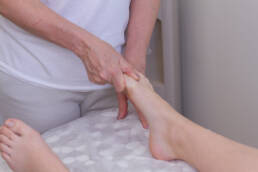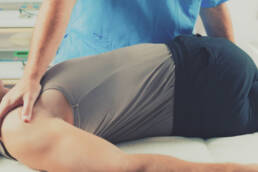Knee pain is very prevalent and causes a loss of lifestyle and enjoyment in its sufferers. Because of this there are 600,000 arthroscopic surgeries and over 700,000 total knee replacements each year. Knee problems can be caused from trauma (i.e. athletics or a misstep), wear and tear and a small percentage of genetic conditions. Through normal course of care your physician may prescribe anti-inflammatory pain medication, physical therapy, lifestyle changes or even an orthopedic consult.
There are two very often overlooked simple, but incredibly impactful solutions that can dramatically improve or solve your knee troubles.
What you need to first understand is that the knee joint is part of a chain of joints that are responsible for your movement. When you walk or run the knee is responsible for transferring energy and motion through this chain that also involves your feet, hips and lower spine. The knee just happens to be right in the middle of this chain. It doesn’t start or direct the motion; it passes it along. The two areas most responsible for directing the knee are your feet and your lower spine. The knee essentially does what it is told.
Your Lower Spine
The lower spine is like a camshaft directing the pelvis and hips through the knee to the feet when you take a step. There is a complicated system of muscles that are activated in the proper proportion for this to happen. Of course the orchestrator of this is your brain and nerve system. That is where the program for walking, running and any other movement is stored and activated from. Proper communication from your brain through your lower spine on the nerves to all of your muscles is required or nothing happens. If there is any interference in that nerve pathway, a person many not have the proper strength or coordination to move properly. In most circumstances a little interference in not noticeable right away, but over time a pattern may arise that is causing the system to work differently where some muscles are used and others aren’t when they should be. This could be the cause of excess twisting at the knee or improper flexion causing you a lot of trouble and pain as the tissues and even bones break down over years.
Errors in the alignment of your spine will cause the breakdown in the mechanics of how you move. This can first be a break down in efficiency (i.e. the difference between someone who can walk for hours and those who fatigue rapidly) but over time it can be the breakdown of function and cause of more pain. But neurologically the alignment of your spine will dictate the communication to your legs. With misalignments it is like a dimmer switch on a light. They won’t be turned off completely; they will be dimmer delivering less impulse to provide coordination, strength and stamina of movement.
To test if your spine is potentially part of the problem:
- Stand straight in an area where you can grab on to something should you become unstable.
- Put your feet together with toes pointed straight ahead.
- Let go of any railings or support.
- Close your eyes.
- Take note of any sway patterns. Are you going to one side or back and forth? Are you making circles? Any of these may indicated that there are stability and or alignment issues in your lower spine. You may need to have someone stand behind you to watch and support you if you become unstable.
Proper spinal alignment is as much about working with the right professional as it is about personal habits. Chiropractor’s number one concern is the proper alignment of your spine to allow a conduit for proper nerve transmission for your body to function the way it was designed. Personally, it is your decision to adhere to habits that promote proper spinal alignment and refrain from those that don’t. As an example, sitting for long hours has been shown to negatively impact the alignment of your spinal column while regular moderate intensity muscle building exercise will strengthen and support a healthy spine.
Your Feet
It might be a little easier to pin a knee problem to ones feet because we so often feel the pain with every step taken. Still, the feet are often overlooked as a possible culprit for your knee pain.
In the chain referenced above, the feet will direct energy and motion up the leg once contact has been made with the ground. The foot is designed to create a stable foundation with the ground. On even ground the foot will go through a cycle that involves heel strike, roll forward and a push off of the big toe. How this is done depends largely on how well the rest of the chain did its job in getting the foot to the ground in the proper position. Once it is there it is up to the three arches of the foot to allow the foot to roll from the outside edge of the heel to the big toe in a controlled fashion. Getting the proper control is challenging because most feet don’t have the necessary arches and stability to begin with and shoes aren’t always made with proper support in mind. What happens if the foot is not properly supported is there will be too much motion, like micro shaking, that that will cause extra muscle recruitment, fatigue and a position change in the body that will sometime put extra pressure and a twist on the knee resulting in problems.
A simple test to see if your feet are doing their job is as follows:
- In bare feet stand straight with legs shoulder width apart.
- Close your eyes.
- Raise on foot off of the ground.
- Notice the effort in your contacting foot. You should be able to stand for many moments without problems. If you are falling to the inside or your ankle is moving back and forth a lot, your feet may not be stable and could be part of the cause of your knee problems.
Proper stability and mechanics of the feet can be addressed with proper footwear, custom orthotics and even proper joint manipulation as a reset. These will insure that the feet do their job and don’t hurt the knees.
Accurately assessing the cause of your knee pain can be somewhat like a puzzle. It is necessary to look at habits (i.e. sitting with legs crossed all day) and make adjustments there first. Next, working with a professional to determine if your feet or spine are in need of correction is necessary. Addressing these areas can ensure that a proper solution is found in a more timely manner allowing you to pursue a lifestyle on your terms!
If you need a chiropractor in Fort Collins, give us a call today or book an appointment online.

Ready for an expert opinion? Set up an appointment today!
Dr. Jeremy Overholt, your Fort Collins chiropractor, is your go-to expert for comprehensive chiropractic care. With years of experience and a dedication to your well-being, he specializes in treating a vast array of health issues to help you live a healthier, more comfortable life.
Like this article? Spread the word!
Related Posts
April 9, 2024
Understanding Peripheral Neuropathy and How Chiropractic Care Can Help
Discover how Inner Vitality, a Fort Collins-based chiropractic practice, offers holistic…
February 28, 2024
Unlocking Wellness: A Holistic Approach to Weight Loss, Nutrition, and Chiropractic Care with Inner Vitality Chiropractic
Discover sustainable weight loss, holistic nutrition, and chiropractic care in Fort…
January 23, 2024
Preventing Workplace Injuries: The Vital Role of Ergonomics and Chiropractic Care
Discover the vital role of ergonomics and chiropractic care in preventing workplace…





